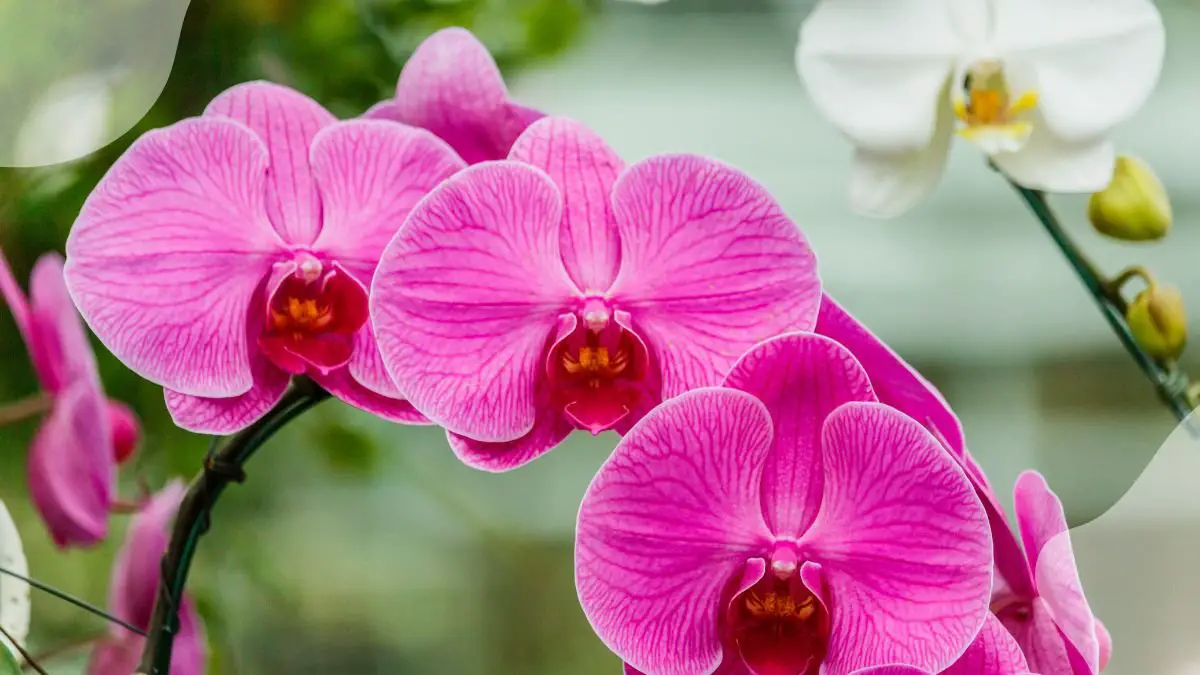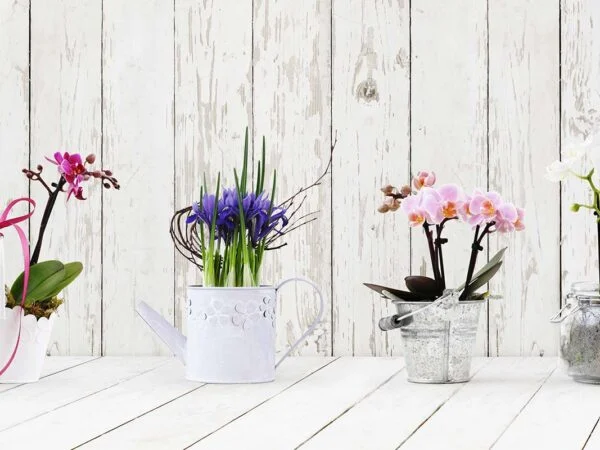Ever wondered what steps to take when your orchid flowers start to wither away? The vibrant blooms that once brought joy are now fading, but fret not - there are ways to revive your beloved plant. From proper pruning techniques to essential care tips, we've got you covered. Discover how to encourage new growth and ensure your orchid thrives for years to come. Ready to breathe life back into your wilting orchid? Let's delve into the simple yet effective strategies that will help you rejuvenate your plant and enjoy beautiful blooms once again with water, balanced orchid fertilizer, and care for your flower.
Key Takeaways
- Understand the Orchid Life Cycle: Knowing the stages of an orchid's life cycle can help you anticipate and respond to changes in your plant.
- Take Immediate Steps After Flowers Die: Trim the spike, adjust watering, and provide proper care to ensure your orchid remains healthy after blooming.
- Continue Care for Non-Flowering Orchids: Even when not blooming, maintain regular care routines like proper watering, light exposure, and fertilization.
- Encourage Re-Blooming: Implement strategies like temperature variations, light adjustments, and proper pruning to stimulate your orchid to bloom again.
- Explore Advanced Care Techniques: Experiment with techniques such as repotting, dividing, or adjusting humidity levels to enhance your orchid's health and blooming potential.
- Avoid Common Mistakes: Stay clear of overwatering, excessive sunlight, inadequate air circulation, and neglecting proper fertilization to prevent common pitfalls in orchid care.
Understanding Orchid Life Cycle
Signs of Flowering
When orchid flowers age, you can observe the appearance of new buds or spikes on your orchid. These signify the plant's readiness to bloom again. vibrant and colorful blooms are clear indicators of a happy orchid.
Look for any changes in the fragrance of the orchid flowers. A shift in scent can signal the beginning or end of the flowering phase. It's essential to pay attention to these details to ensure proper care.
Post-Bloom Phase
Prepare for the transition after your orchid has finished blooming. This is a crucial period where the plant may need different care. Understand the changes your orchid may undergo post-blooming to provide appropriate support.
Plan for the care adjustments needed during the post-bloom phase. This includes modifying watering schedules, light exposure, and fertilization to help your orchid thrive even after flowering. Stay attentive to its needs to promote healthy growth.
Immediate Steps After Flowers Die
Trim Dead Flowers
When orchid flowers die, it's crucial to remove them promptly to promote new growth. Use sharp, sterile scissors to trim the flower spike, cutting it just above a healthy node. By doing this, you encourage the plant to focus its energy on producing new blooms.
- Remove wilted or dead flowers from your orchid plant.
- Trim the flower spike carefully to promote new growth.
- Ensure proper tools and techniques for trimming dead flowers.
Assess Plant Health
After orchid flowers have faded, it's essential to evaluate the overall health of your plant. Inspect the leaves, roots, and stems for any signs of damage or disease. Healthy roots are firm and green, while unhealthy ones may appear mushy or brown.
- Check the overall health of your orchid plant post-flowering.
- Monitor the leaves, roots, and stems for any signs of distress.
- Evaluate the need for any specific treatments based on plant health assessment.
Care for Non-Flowering Orchids
Watering Needs
Adjust the watering schedule based on the orchid's blooming cycle to prevent overwatering. Maintain a consistent watering routine to promote healthy root development and avoid root rot issues. Monitoring soil moisture levels regularly is crucial to ensure the orchid's well-being.
Light Requirements
Position the orchid in an area with adequate light exposure, especially after flowering, to support photosynthesis. Avoid placing the orchid in direct sunlight to prevent leaf burn. Providing sufficient indirect light is essential for the orchid's growth and overall health.
Fertilization Tips
Implement a balanced fertilization routine suitable for post-bloom orchids to nourish the plant adequately. Choose an orchid fertilizer with a balanced ratio for regular feeding sessions. Following specific guidelines for fertilizing orchids is crucial to maintain healthy growth and vibrant foliage.
Encouraging Re-Blooming
Temperature Adjustments
When your orchid new spike finishes flowering, tweak the temperature settings to aid re-blooming. Consistency in temperature is crucial to prevent stress on the plant. Be mindful of seasonal temperature changes, as they can impact your orchid's growth and blooming cycle.
Repotting Essentials
To promote re-blooming, keep an eye out for signs indicating the need to repot your orchid. Choose a suitable orchid potting mix and containers for the repotting process. Adhering to proper repotting techniques is essential for a successful transplant and future blooming.
Humidity and Airflow
Maintaining optimal humidity levels is key to encouraging re-blooming in your orchid. Ensure there is adequate airflow around the plant to avoid stagnant air, which can hinder growth. Consider using misting techniques or humidity trays to create a favorable environment for your orchid.
Advanced Care Techniques
Orchid Rest Period
Allow your orchid to rest after blooming to support its overall health and future blooming cycles. During this phase, maintain a stable environment with consistent light, temperature, and humidity levels. Avoid moving or repotting the orchid to minimize stress during its rest period.
Creating a conducive environment for the rest period involves placing the orchid in a location with indirect sunlight and ensuring proper air circulation. Limit watering to prevent root rot and allow the plant to gradually transition into dormancy. By providing a calm and stable setting, you enable the orchid to recharge and prepare for its next blooming season.
Seasonal Care Variations
Adjust your orchid care routine according to seasonal changes to meet the plant's evolving needs throughout the year. In colder months, increase humidity levels by misting the orchid or using a humidifier. During warmer seasons, provide adequate ventilation to prevent heat stress.
Consider factors such as temperature, light exposure, and humidity when implementing seasonal care variations for your orchid. For example, reduce watering frequency in winter to prevent overwatering and adjust fertilizer application based on the plant's growth cycle. By planning ahead and adapting your care routine to seasonal shifts, you can promote optimal growth and flowering in your orchid.
Common Mistakes to Avoid
Overwatering Issues
Recognize the signs of overwatering in your orchid plant. Look for yellowing leaves, mushy stems, and moldy soil. Adjust your watering routine to prevent overwatering post-flowering. Ensure proper drainage to avoid water accumulation that leads to root rot. Address any root rot promptly to save your orchid from further damage.
Neglecting Light Needs
Don't overlook the light requirements of your orchid after it blooms. Place your orchid in a spot where it can receive indirect sunlight for about 6-8 hours daily. Adequate light is crucial for photosynthesis and overall plant health. Lack of light can cause issues like leaf damage, weak stems, and poor blooming.
Improper Pruning
Learn the correct techniques for pruning your orchids after they finish flowering. Use sterilized tools to trim dead stems and faded flowers carefully. Avoid cutting healthy parts of the plant, as this can hinder future growth and blooming. Proper pruning promotes new growth by redirecting energy to healthy parts of the orchid.
Frequently Asked Questions
Reblooming Timeframe
Orchids need time to rebloom after their flowers have wilted. Typically, orchids take several weeks to months to start blooming again. Monitor the plant closely for any signs of new spikes or buds emerging. Be patient and consistent in your care routine as you wait for the orchid to rebloom.
Leaf Care During Dormancy
During dormancy, it's crucial to pay attention to the condition of the orchid's leaves. Monitor leaf color, texture, and hydration levels regularly to ensure they remain healthy. Make necessary adjustments to your care practices to support the vitality of the leaves during this period.
Watering Schedule Adjustments
Adjusting the watering schedule is essential for the overall health of your orchid. Modify the watering frequency based on seasonal changes and the plant's specific needs. Take into account factors like humidity levels and temperature variations when fine-tuning the watering schedule. Avoid issues like under or overwatering by maintaining a balanced watering routine.
Success Stories
Before and After Photos
Capture the transformation in your orchid plant from blooming to post-bloom phase. Document the changes through photos. Compare images to track progress.
Visual evidence is crucial in monitoring your orchid's growth. Take photos at regular intervals to observe development.
Testimonials
Share personal experiences related to orchid care. Highlight positive outcomes achieved by following recommended practices. Provide testimonials from enthusiasts or experts.
Testimonials can be a source of motivation for beginners. Hearing success stories can boost confidence in caring for orchids.
Closing Thoughts
You've learned how to navigate the life cycle of your orchids, from post-flowering care to encouraging re-blooming. By avoiding common mistakes and implementing advanced techniques, you can ensure your orchids thrive. Remember, patience and consistency are key in caring for these delicate plants. Keep up the good work, and you'll soon be sharing your success stories too!
Frequently Asked Questions
How do I know if my orchid is dead or just dormant?
If your orchid appears to have no leaves or roots, it may be dead. However, if there are healthy roots and leaves, it's likely dormant. To confirm, gently tug on the roots - if they are firm and green, your orchid is alive.
Can I cut the stem after my orchid flowers die?
Yes, you can trim the flower spike down to the base once all the flowers have withered. Cut it just above a node using sterilized scissors. This encourages the plant to focus its energy on new growth rather than maintaining the old spike.
How often should I water my orchid after the flowers fall off?
After the flowers drop, reduce watering frequency to prevent overwatering. Water your orchid once every 7-10 days, allowing the roots to dry out slightly between waterings. Adjust based on humidity levels and the specific needs of your orchid variety.
Should I fertilize my orchid after it has finished blooming?
Yes, you can continue to fertilize your orchid after it stops flowering. Use a balanced orchid fertilizer diluted to half-strength and apply it every 2-4 weeks during the growing season. Fertilizing helps support overall plant health and potential re-blooming.
How long does it take for an orchid to rebloom?
The time it takes for an orchid to rebloom varies depending on factors like species, care conditions, and genetics. Generally, Phalaenopsis orchids may take around 8-12 months to rebloom under optimal care. Be patient and maintain consistent care routines for best results.
Image Source: Paid image from CANVA



